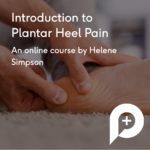Are orthotics useful for treating PTTD?
The tibial is posterior is considered the main dynamic stabilising muscle of the medial longitudinal arch height and dysfunction is a common cause of foot pain. Posterior tendon dysfunction (PTTD) takes place when pronation is prolonged until the end of the stance phase of walking which can cause pain, gait disturbance, excessive mechanical stress and medial longitudinal arch collapse.
A 2 stage classification tool for PTTD is the Bluman and Myerson’s refined classification of PTTD.
Type I: Tenderness along posterior tibial tendon (+/- 5 degrees hind foot valgus)
Type II: Flexible hind foot valgus, lower limb weakness and foot dysfunction which can be broken down into sub classification:
IIA: Forefoot varus and possible PTT pain
IIB: Forefoot abduction
IIC: Fixed forefoot varus with medial column instability and first ray Doris flex ion.
Treatment for PTTD often includes orthotics with the objective of stabilising and supporting the medial longitudinal arch as well as controlling the hindfoot valgus angulation. There is inconclusive evidence for the effectiveness of orthotic treatment for type I or II PTTD and this systematic review aimed to be the first of its kind in answering this question.
Method
This was a systematic review involving 4 RCT studies which included 189 patients. The review was prosperous registered and adhered to Prisma. There was decent explanation of the review methods for the articles as well as analysis of risk of bias. Clearly the studies involved are not huge and due to their size there is an element of bias which needs to be considered when interpreting the results. It’s also quite difficult to blind participants to orthotics!
Clinical Relevance
The aim of the systematic review was to answer the question of whether orthotic treatment was effective at treating stage I and II posterior tibial tendon dysfunction.
Each study included within the review used different types of exercise and different orthoses therefore it is difficult to draw firm conclusions. The exercises varied from gastroc stretching, progressive tib post concentric or eccentric exercises and ankle plantar flexion exercises. Of all the exercises included the group which included concentric exercises plus orthotics showed the most improvement over 5MWT and VAS. The only study to use orthotics only did not improve as much as any of the orthotic plus exercise trials.
For all studies included there was particular reference to the importance on comfort and compatibility with shoes. After all if the orthotics don’t fit the shoes or are uncomfortable to use patients won’t adhere! Therefore always consider a custom insole first and foremost.
